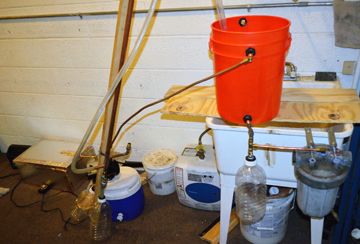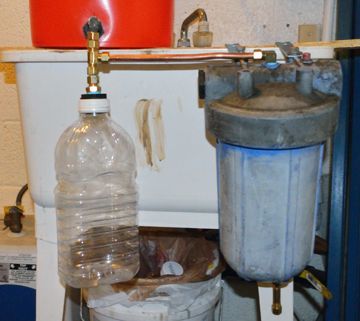I have just gotten through all of the thread, pretty hard to retain all the info in one sitting so i will do a job on the thread & compile all the text into one document for ease of reading at lesuire,
Regarding this set up below,
I am looking to use this reflux column as it seems it would be very efficient space wise (i dont have a huge amount of space)
Let me ask a question, the three stages of the column are condensing the vapours at seperate temperatures to obtain the different desired fuels, i recall reading from IMBD that for diesel the temp should be 160' in the reflux to condense diesel, what are the temps in the other two sections of the column to be at?
Also, what is the best way to regluate the reflux over the space of the column? One cooling coil at the head with adjustable temperature liquid circulating & the reactor temperature then also adjustable bbetween 300' & 450'?
I was looking at modifying an old cooker to use as heat source, the two heating elements contained within the cooker (Grill & Oven) are 2000w each, the two front rings on the top are 2000w & the two back rings are 1500w, thats a combines total power of 11000w.
Is it possible to detach the elements & rings from there supply & fit suitable coils to the power supplies which you then have very good control over to heat the reactor temp to a specific temp?
You would have 6 potential dials to increase or decrease any given element?
Does this sound like something that can be done or are the fitting no adapatbale on a cooker?
I think i covered it in the question above, what are the three desired temp stages if i were to build a reflux column like the design above in order to condense the vapours at each stage, trail and error will be the only way to finally acchive it in each section, just need to know what they are.
Having finished out the thread, it appears that my post above here only matters if it is a coninous fed system, the small amount of oxygen in the system can be pushed out by adding water, yes?
Anyone offer a guide as to quantity of water to plastic ratio?
How much would you put in to clear the O2 but not be a problem?
Finally, i read a good few pages back you were using a mixture of plastics, what is the viability of using the likes of industrial shrink wrap, clear plastic bags & strapping like below,

The bags would be baled into compressed bales with a baler like this,

There would be an amount of O2 still in between the bags but this should not be an issue if melted slowly, should it?
Regarding this set up below,
Originally posted by drmattfombong
View Post
Let me ask a question, the three stages of the column are condensing the vapours at seperate temperatures to obtain the different desired fuels, i recall reading from IMBD that for diesel the temp should be 160' in the reflux to condense diesel, what are the temps in the other two sections of the column to be at?
Also, what is the best way to regluate the reflux over the space of the column? One cooling coil at the head with adjustable temperature liquid circulating & the reactor temperature then also adjustable bbetween 300' & 450'?
Originally posted by Jetijs
View Post
Is it possible to detach the elements & rings from there supply & fit suitable coils to the power supplies which you then have very good control over to heat the reactor temp to a specific temp?
You would have 6 potential dials to increase or decrease any given element?
Does this sound like something that can be done or are the fitting no adapatbale on a cooker?
Originally posted by imakebiodiesel
View Post
Originally posted by Uncorruptable
View Post
Anyone offer a guide as to quantity of water to plastic ratio?
How much would you put in to clear the O2 but not be a problem?
Originally posted by imakebiodiesel
View Post

The bags would be baled into compressed bales with a baler like this,

There would be an amount of O2 still in between the bags but this should not be an issue if melted slowly, should it?

 and also is diesel an acid or a base
and also is diesel an acid or a base
 & sure enough it would turn out very difficult i imagine, but i would be looking to attempt this.
& sure enough it would turn out very difficult i imagine, but i would be looking to attempt this.

Comment